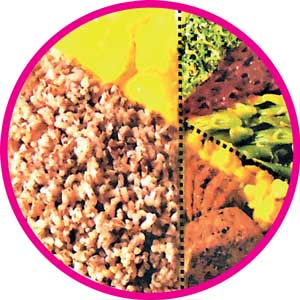Reply To:
Name - Reply Comment
Last Updated : 2024-04-18 08:56:00

The nutrition month is commemorated by the government in June every year. However, this year’s theme formulated by the Health, Nutrition and Indigenous Medicine Ministry is ‘Shape your meal to shape your body,’ interpreted as measure and eat to be in shape. In Sinhala it is ‘Hadata Inna, Manala Kanna.’

This is indeed an appropriate theme for the country at a time it faces the burden of both under and over nutrition. Underpinning this subject matter are several elements. It is reported that there are approximately 4.4 million diabetic patients in the island, which is roughly 1/5th of the population. Research published in the International Archives of Medicine in 2014 on ‘Nutrient Intakes of Sri Lankan Adults’ states that 25% of Sri Lankans suffer from metabolic syndrome and 73% of energy in the diet comes from carbohydrates, which is somewhat high for sedentary people. However, this random survey included only 400+ heads in a population of a little over 20 million.
It is vital that these themes go beyond a mere ‘event’ and impact on the individual and community level. A favourable atmosphere should be created to achieve actual behavioural change, so as to have a positive impact on the lives of the people. Policy changes, effective strategies and measures are essential to commit the resources to ‘walk the talk.’

What is not depicted in the plate is fruit, which should also be consumed and fats which are essential if one is to complete the meal. The World Health Organisation (WHO) recommends the inclusion of carbohydrates in a diet at a concentration of 55% to 75%. It should also be kept in mind that the energy derived from carbohydrates and the actual inclusion of proportions of food groups are not exactly the same.
Meanwhile, the US Dietary Guidelines 2010 suggests that the contribution of energy from carbohydrate in a diet should be in the range of 45% to 65%. The plate also does not have a proportion for fats. It is assumed that this is not stated, as fat in a diet is one of the major offenders for NCDs. However, while fat is essential, the general minimum recommendation is that 20% of the daily intake of energy in a diet should be from fats.
Despite these concerns, the Health Ministry ‘shaped plate’ is appropriate, but only if there is a supportive environment to encourage individuals to follow stipulated guidelines.
In light of the aforesaid inconsistencies between theory and practice, policymakers in Sri Lanka need to give due consideration to the following points:
|
The first consideration when driving forward programmes is the availability and affordability of resources. Thus, it is required to analyze the quantities and food groups recommended on the plate when considering in the current Sri Lankan context.
Carbohydrates (starch) – recommended proportion 50%:
At present, the population of Sri Lanka stands at 20,810,000. This number, excluding very young children, is required to eat the quantities recommended in the shaped plate. The farming population requires a little more than the shaped plate which is really designed for the urban man or woman who has a propensity to acquire NCDs with a more sedentary lifestyle and less healthy meals filled with processed food.
However, Sri Lanka is gradually emerging out of its ‘food deficit’ status as per the definition given by the WFP and FAO, and is steadily increasing its rice production with a per capita supply of over 255g per day. The country could carefully balance the rice produced with that consumed. This task is made easier as children would not consume large quantities of rice and the whole population does not consume rice in all three meals per day.
Therefore, to conclude the picture on starch, the amount available per capita with other cereals taken into consideration, is barely sufficient even with the plate recommendation restricting starch up to 50%. However, policymakers must remember that starchy food also contribute essential proteins at a lower cost than major sources of protein like fish, meat, eggs, pulses and milk products.
Protein – recommended proportion 17%:
The plate recommendation for protein rich food is 17% which translates to approximately 25g per meal. The daily requirement at 1g per kg of body weight is approximately 50g to 60g per capita. According to latest census figures, the availability of protein per capita per day is 75g. Of this, nearly two thirds are vegetable protein. Protein rich foods also provide much needed minerals including iron, zinc and B vitamins (especially B-12). Given a net protein utilization of 80% in combinations of meat and legumes, the body will only use 60g of the 75g available. Protein availability is limited as can be seen from the calculation above, and the prices are driven high, owing to a limited supply. Eroding into the available animal protein are exports, especially sea food which is freighted from the country in large quantities.
Vegetables and Greens – recommended proportion 33%:
Let us now turn to that most important component of vegetables and greens, depicted as 33% of the plate. The recommendations on vegetables and greens are not very clear. However, the best case scenario across the world recommends 400g of vegetables, greens and fruit to be consumed per day, and half of this quantity to be included in main meals. This is at times expressed as two cups of vegetables, one cup greens and two cups fruit per day. A family of four, eating rice for two meals per day in an urban setting where the shaped plate is most needed, requires eight cups of vegetables and four cups of greens.
Added to this would be eight cups of fruit outside the plate. In weight this is a minimum of 1 kilo of vegetables, a bunch of green leaves and 1 kilo of fruit per family of four per day (calculated with the peel, seeds and so forth). This can be rounded to approximately 1.6 kilos of cleaned vegetable, greens and fruits.
According to a market survey of average prices of fresh produce in both retail and wholesale markets over the past 6 months, this family would require Rs.450 per day to afford the 33% on the plate. This amounts to some Rs.13,000 per month. The fact that fruit consumption is so low is no surprise as 90% of fruit (according to the Chamber of Commerce, 2015 statistics) produced in the country is exported, affecting both price and availability. Meanwhile, the ‘concerned scientists’ group in the US confirms that an extra serving of fruit would serve 30,000 lives and reduce health expenses by five billion US dollars. The steep rise in food prices in Sri Lanka over the past six months alone is a limiting factor for nutrition improvement.
It is assumed that in a village environment, meeting the requirement of a cup of vegetables and half a cup of greens per meal is not difficult due to the availability of homegrown produce. However, practical assessments done at the field level paint a very different picture. To cite one example, assessments carried out in rural farming communities under the Supporting Opportunities in Livelihoods Development (SOLID) Project revealed that this figure was in fact inaccurate in many of the project’s target communities. The SOLID Project targets farming households in the Northern, North Central and Eastern Provinces where agriculture is the main source of income. Evaluations assert that the farmers did not consume more than four food groups out of the critical nine. Consumption of fruit was extremely poor. Most families repeated the same vegetables and ate very small quantities. Despite the fact that Sri Lanka is home to over 250 types of green leaves, only about 10 types are actually eaten as part of the everyday meal.
Compounding the factors mentioned above is the fact that most policies are based on proxy indicators and Nutrition Status Surveys mainly of the under five age group. There has never been a comprehensive dietary intake study on what people in Sri Lanka really eat.

Add comment
Comments will be edited (grammar, spelling and slang) and authorized at the discretion of Daily Mirror online. The website also has the right not to publish selected comments.
Reply To:
Name - Reply Comment
On March 26, a couple arriving from Thailand was arrested with 88 live animal
According to villagers from Naula-Moragolla out of 105 families 80 can afford
Is the situation in Sri Lanka so grim that locals harbour hope that they coul
A recent post on social media revealed that three purple-faced langurs near t

10 Apr 2024
09 Apr 2024